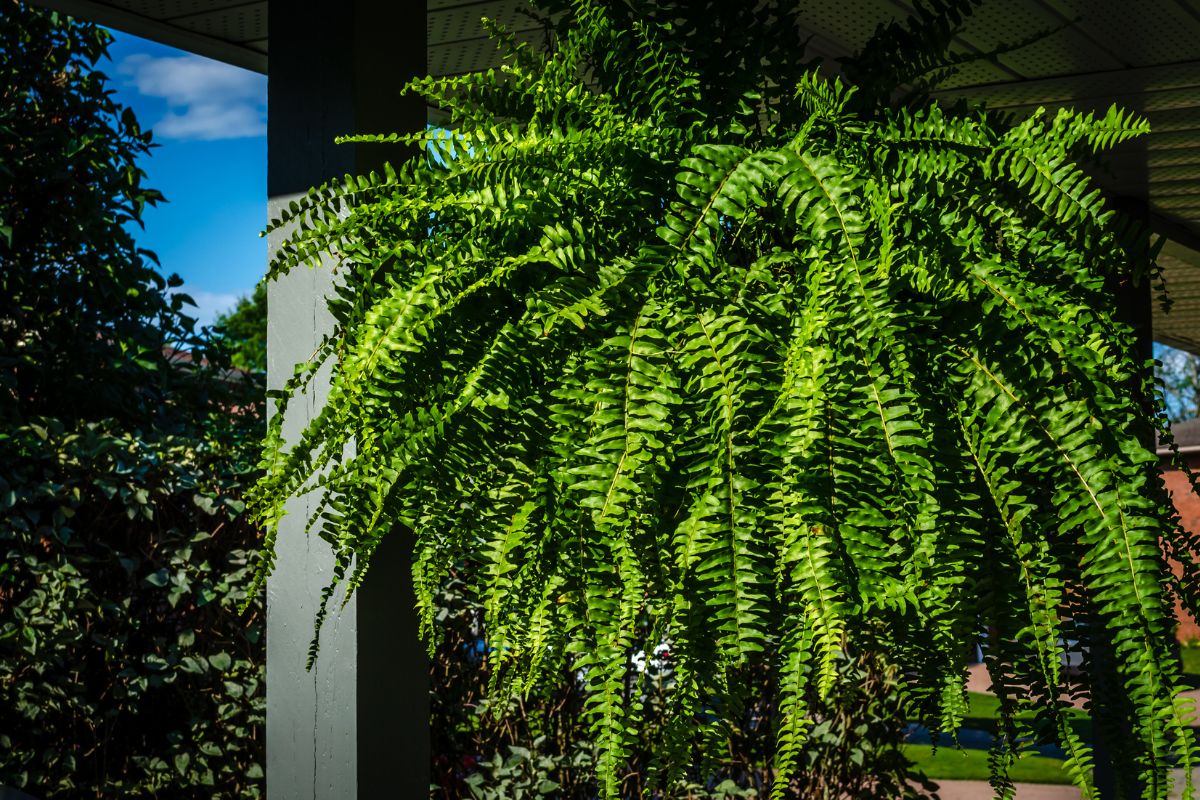What is a Boston Fern?
Boston Fern care outdoors is simple if you follow the process efficiently. Boston Fern (Nephrolepis exaltata) is a fern species with several tiny, sword-shaped leaves. Boston Ferns grow well indoors and outdoors, especially in humid conditions.
A Boston Fern thrives in a hanging basket on a porch with moderate sunlight. You can keep it for years if you take good care of it.

How to Care for Ferns Outside
When growing Boston Ferns outside, you must adhere to the same guidelines regardless of whether you use a garden bed or a container. Here are the fundamentals of Boston Fern care outdoors.
Choose the Right Spot
Boston Ferns do best in partial or complete shade, though filtered, dappled light also works. They are a great way to add some color to any wet, shaded corners of your yard. Because of this, many people raise Boston Ferns on covered patios with little or no sunshine.
It is important to protect these plants from the wind because the soil dries up more quickly in the wind. Nobody wants to cope with frequent watering due to drying winds.
Use the Correct Container
Use a container between 1 to 2 inches (2.54 to 5.08 centimeters) in diameter. If you wish to move your plant, the container should be larger than the previous one if you grow ferns in containers.
A self-watering pot is a great choice because it keeps the soil moist, which is important for growing ferns. Utilizing a plastic pot is another choice because it slows evaporation. You should also ensure that the container has drainage holes to keep the soil from getting soggy.
Create the Right Soil for Boston Ferns
These plants prefer nutrient-rich organic soil whether you use containers or not. If your garden soil has poor quality, improve the humus content while also ensuring that the soil drains properly by adding several inches/centimeters of compost, leaf mulch, or finely chopped bark.
You should always use potting soil that is specifically for pots when growing ferns in containers. You can amend the soil with peat moss and perlite to increase airflow to the roots and ensure good drainage. Do not use peat moss excessively since it can make your soil too acidic.
Give Plenty of Water
Boston Ferns require a lot of water to survive; they are not drought-tolerant plants. The soil should always be moist but not drenched in water or soggy. Furthermore, avoid leaving standing water around your plants. And those who live in arid climates should mist their plants on hot days since humidity is necessary for healthy growth.
Plants growing in containers require more regular watering since the perforations allow water to flow quickly. On days with high temperatures, check your plants more than once. Also, check them every day. During such days, Boston Ferns may require a second watering.
Furthermore, over-watering promotes the growth of root rot. Your plants may perish as a result of the root rot. Thus, it is best if you water your plants with lukewarm water.
You need to water your fern more if it appears pale or starts to yellow. Increase your watering frequency when new fronds emerge at the end of spring.
Fertilize as Necessary
Boston Ferns only need periodic fertilizer applications because they don’t need much of it. Yellowing or pale leaves are signs that your plant doesn’t have enough nutrients to grow.
If you don’t notice these signs, fertilizer is still a good idea throughout the season; every six to eight weeks is a suitable interval for feeding. Consider feeding the plant in the spring with a slow-release fertilizer or a water-soluble fertilizer.
Beware of Pests
The fact that pests don’t affect Boston Ferns too much is one of the best reasons to plant them, but that doesn’t imply they are impervious to pest attacks.
The biggest pest threat to your plants is the popular bug, slugs. One approach to the slug issue is to check your plants in the morning or evening and manually remove the slugs. Another option is to sprinkle coarse materials, like eggshells, over the soil.
Repot When Needed
If you grow your ferns in a container, you will need to repot them as your plants get bigger and bigger. When repotting, make sure the new pot’s diameter is no more than 1 to 2 inches (2.54 to 5.08 centimeters) but larger than the old one.
Make sure to wash the pot well with hot water and soap before using it if it was already used. Old containers harbor bacteria, and you don’t want your healthy fern plant to get infected.
Propagate by Division
You can multiply Boston Ferns by root division. Because ferns can become root- or pot-bound, making it difficult to water your plant, dividing your fern is a crucial step. You can divide your fern when the roots fill the pot and repot half of it somewhere else.
Plant division and repotting work well in the spring. Before removing the plant from its pot, let the soil completely dry out. Cut the roots apart using a knife with a serrated edge. Then, place each division in a new pot with fresh composted potting soil. Also, the pot should be well-watered to aid in the roots’ establishment.
Prune Your Outside Boston Ferns
Some of the Boston Ferns’ leaves may become withered, brown, or discolored if they grow throughout summer outdoors. The Ferns require pruning, much like many other plants. Pruning removes the dried-out or discolored fronds. Therefore, trimming out dead ends is like giving your plant a good haircut.
Ferns respond strongly to rigorous pruning, which promotes bushier, healthier growth. Therefore, cut off all of the old foliage in the early spring before the Boston Ferns come out of dormancy if you wish to prune them severely. Your plant will soon be lush and have fresh fronds.
Overwinter Boston Fern Plants
When the weather turns chilly, most people throw their Boston Ferns in the trash, which is wasteful and useless. If you offer efficient care during winter, ferns can keep growing for years.
The first step is finding the ideal spot for Boston Ferns to spend the winter. If your residence is too warm and dry, it can be difficult to bring your plants inside. When grown as a houseplant, ferns require high humidity levels and temperatures below 75 degrees Fahrenheit (23.88 degrees Celsius).
Also, allow your ferns to go dormant and keep them in your garage, cellar, or outdoor structure where the temperatures don’t go below 55 degrees Fahrenheit (12.77 degrees Celsius) if the interior of your home doesn’t meet the requirements.
A dormant Boston Fern requires very little maintenance. Therefore, ensure no light can reach the plant because they are asleep. Additionally, water the plant thoroughly, but only occasionally.
Overwinter Boston Ferns Outside
Boston Ferns can overwinter outside if you live in a subtropical region without cold temperatures or frost. Only people who live in USDA zones 8B–11 can try to accomplish it without their plants dying.
These recommendations will help you maintain your outdoor fern plants over the winter:

Prune Your Plants
The ideal time to prune ferns is before the winter. It’s essential to leave newly sprouting fronds on your plant, especially if you’re bringing it inside. This will stop your plant from losing all of its old leaves.
Don’t Move Abruptly
If you decide to relocate your plant, don’t make the change right away. The environment should change gradually.
Stop Fertilizing
Do not fertilize Boston Ferns all winter long. When fresh shoots emerge from the soil, you can resume feedings and routine watering.
Are Boston Ferns Perennials?
With the right care, Boston Ferns can grow as perennials indoors. This means you will continue to enjoy your plant for many years, if not decades. The oldest Boston Ferns go down through the generations dating back more than a century. Therefore, they deserve all the attention and care that you can provide.
What About Outside? Perennials or Annuals?
When growing fern plants outdoors, they can be either annual or perennial plants, depending on the climate.
The Boston Fern is a perennial but can’t stand very cold weather. The plant may perish if wintertime temperatures drop below 55 degrees Fahrenheit (10 degrees Celsius). Due to their poor cold tolerance, tropical and semitropical plants, like the Boston Ferns, are unlikely to endure freezing temperatures.
Bring your Boston Fern inside as soon as the temperatures begin to fall if you live in a region with colder winters and want it to remain a perennial and bring you joy for many years. It’s that simple to stop your Boston Fern from dying.
Even though the plant is perennial by nature, harsh winters will shorten its lifespan to just one year. Thus, it won’t come to life again as the weather warms up in the spring.
If you live in such cold areas, it is best to avoid planting them directly in the ground. Boston Ferns prefer to grow in pots; if they do, you can move them easily.
Suppose a Warmer Climate?
The Boston Fern can stay outside all year if you live in a warmer region and the weather doesn’t get too cold. Be aware of the occasionally changing weather patterns. Even if you live in a region with typically warm temperatures, the temperatures might occasionally fall below average.
If your area has an all-year-round favorable climate, you can plant the ferns directly in the ground. They will gladly develop into stunning ornamental ferns. Furthermore, you would likely need to modify your watering schedule if your plant was previously indoors. On average, watering Boston Ferns frequently is necessary when they grow outdoors.

That’s All, Folks
Boston Ferns are the ideal porch plant as they do well in lots of indirect light. Therefore, ensure that they get the morning sun since the afternoon sun might burn the fronds. Boston Ferns provide a lovely mid-height ground cover in locations with dappled shade in humid, subtropical regions of Florida (zones 10 to 12).
They prefer soils with steady moisture that drains properly. While not in direct sunlight, place Boston Ferns planted indoors close to a window.
Boston Ferns will expand to fill the pot. Thus, it’s acceptable to leave Boston Ferns in their plastic pots when purchased because they are frequently available as hanging baskets. Choose plastic or glazed terra cotta if you want to put your Boston Fern in a different pot.
Finally, when a huge Boston Fern is growing in coco coir or an unglazed container, unglazed pot, window box, or hanging basket, it can be challenging to maintain enough moisture levels. Your ferns will flourish if you follow the Boston Fern care instructions well. Always ensure the environment is favorable for your plant, and also ensure that you water and feed appropriately. Read our article and find out more about Do Ferns Come Back Every Year?
